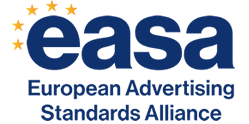EASA and its members work together to ensure that gender is portrayed responsibly in advertising.
The subject of stereotypical portrayal of women, and to a lesser extent men, in advertising has provoked much public debate since the 90s. EASA believes that it is important that women and men are portrayed positively and responsibly in advertising, and that issues around the portrayal of gender should be handled with care in all marketing communications.
All national codes are based on international standards and go far and beyond legal requirements promoting high content standards and helping ensure responsible advertising. EASA’s 26 national advertising codes enforced by the 28 self-regulatory organisations in Europe are based on the International Chamber of Commerce’s Advertising and Marketing Communications Code (ICC Code). Under article 2 on Social responsibility of the Code, marketing communications should respect human dignity and never incite or condone any form of discrimination, including based on gender.
Advertising self-regulatory organisations (SROs) regulate ad content across all media according to local rules, inspired by the ICC Code. SROs develop, implement, and enforce high content standards for specific products with stakeholders’ full support. The ultimate goal of collective ad self-regulation is to foster trust, which in turn helps create a trusted and mature competitive market. The exact type of ethical rules, guiding instruments, or standards that SROs develop is discussed and decided at local level with the concerned brands, both global and local ones. The codes complement national legislation and are enforced by national self-regulatory organisations.
Given questions around gender depiction is deeply tied to cultural and local societal structures of feeling and mindsets, international standards and EU legislation rarely go into much detail, as each European country will have differing sensitivities, varying levels of acceptance of, for instance, nudity, and diverging opinions on what is acceptable to display in ads. Therefore, SROs are uniquely well positioned to formulate advertising rules that address local sensitivities and cater to cultural particularities thereby guiding marketers to responsible practices. An ad depicting people under a particular light may be acceptable in one country and deeply offensive and distasteful in the neighbouring. The French Conseil d’Ethique Publicitaire’s 2024 comparative study on the different models of ad self-regulation across the European continent dives deep into this issue, showcasing differing SRO perspectives on the same ad:
Because of cultural differences, advertising that is acceptable in one country may not be acceptable in another, and vice versa. This may lead to the conclusion that Europeans have variable geometry standards, or at least an acceptance of standards that varies from country to country. […] The complexity lies in the fact that this arbitration is no longer based solely on established rules, but is also influenced by cultural factors. The decision to broadcast an advertisement is often linked to the perception that it could be offensive to certain people or to the fact that the product concerned, although legal, is controversial for societal, moral or community reasons.
When advertising practices in the area of gender depiction are deeply problematic, harmful, offensive, or even illegal, self-regulatory organisations can rely on a legal backstop. This in turn allow statutory authority to issue fines, launch sanctions, or impose judicial measures against rogue advertisers, agencies, or media actors.
Every year, roughly 30% of complaints lodged with SROs almost exclusively by consumers for free take issue with seemingly problematic gender portrayal, discriminatory behaviour, offensive content, fearmongering or violent content, or simply inappropriate content for children.








